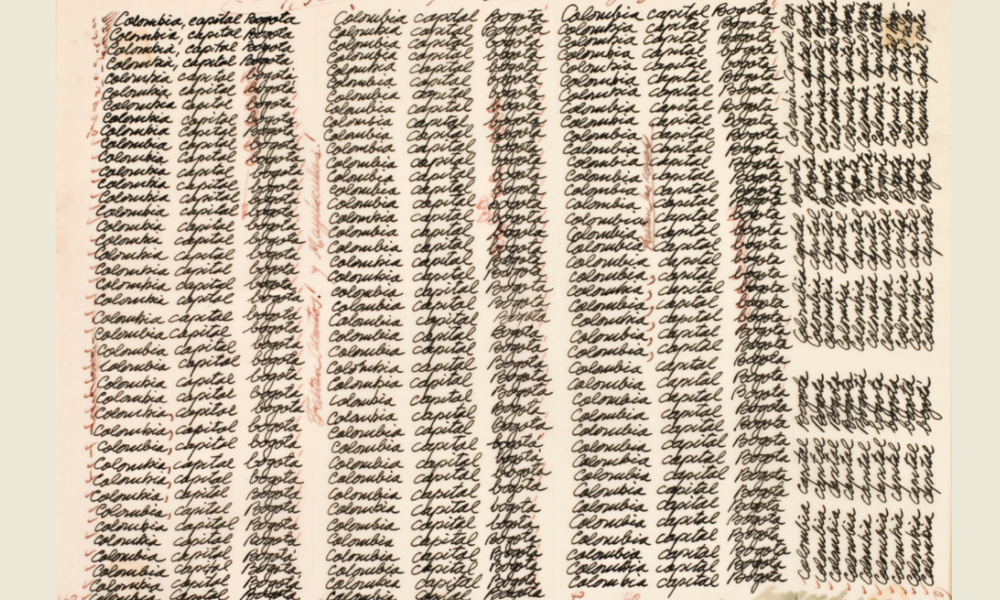The Time of the end: 9 artists at Galería ICPNA Miraflores
Con curaduría de Valentina Gutiérrez, directora del espacio El Dorado, se presenta desde el 16 de marzo y hasta el 8 de abril una multidisciplinaria que examina manifestaciones del cuerpo humano a partir de diversas prácticas artísticas. En el recorrido, se evidencia un cuerpo deconstruido y representado por sus vestigios y una corporalidad que emerge por medio de prácticas metódicas y repetitivas.

"The works we have in this exhibition are close to Catholic retrogression in Colombian contemporary art in two ways: the quest to sacralize the common and the strategies used to do it," says Valentina Gutiérrez curator of the show and director of El Dorado . "The artists repeat, reiterate and ritualize certain ways of proceeding; they play with the limits between control and pain, atone for guilt and make symbolic sacrifices to make sure they are present. "
In this collective exhibition we can find installation, photography, painting and drawing in the works of the artists Leonel Castañeda, Antonio Castles, Ana María Gómez López, Camilo Leyva, Santiago Montoya, Julieth Morales, Luz Adriana Vera, Alejandro Salcedo and Bernardo Salcedo.
The exhibition is organized in conjunction with Espacio El Dorado, a contemporary art gallery located in Bogotá. Its name comes from the legend of El Dorado because, although this city of gold was never found, the illusion was enough to do the impossible. That is what El Dorado seeks to show: ambitious and seemingly impossible ideas, projects that profoundly change the identity of the artist, the space and the art scene. The space has been invited to participate in important art fairs such as ARTEBA (Argentina), ARTBO (Colombia), ARTISSIMA (Italy). This year they will participate in PArC Lima, in the new proposals section.
As for the artists, Bernardo Salcedo will present, with his series Planas y Puntas emphasizes phrases that are insistently repeated in his childhood notebooks and that have become maxims despite their lack of meaning. This work shows how these pedagogical strategies build imaginary and correct deviations that may occur.
The golden number or the divine proportion is an irrational number to which an aesthetic, almost mystical, character is attributed. The religious paintings made in the Renaissance and the Baroque respected this proportion to emphasize the divinity of the figures represented. Alejandro Salcedo develops his work around the golden spiral, a derivative of this proportion and relates it to glamor, understood as an object of desire that is unattainable.
Santiago Montoya and Camilo Leyva show how art continues to create cult objects. Leyva deals humorously with the place of figurative painting within the appreciation of art, questioning the importance of authorship and commenting on the precariousness of work in our times. Montoya takes emblematic figures from narco-aesthetics and mixes them with materials heavily symbolically loaded with cocoa hippos covered with gold, a reference to those of the Hacienda Napoles by Pablo Escobar.
The bodies and the way they are constructed, is another axis of the exhibition. Luz Adriana Vera and Leonel Castañeda work from vestiges, confronting the divine and celestial bodies with reality. Antonio Castles uses long exposure photography to show the absence of bodies in the city of Bogotá during the World Cup, showing how today there are traditions and hobbies that are cult and idolatry. In his still lifes, Castles makes a memento mori reminding us that we are in the time of the end.
The ideas of Judeo-Christian guilt and redemption have permeated other cosmovisions that exist in the country. Julieth Morales shows the connections between the Colombian mestizo culture and Misak, to which it belongs. In his performance we see how the fabric, which in the Catholic religion suppresses desire in the nuns, is used for the same purpose within its tradition.
Finally, Ana María Gómez López uses her body as an object of study with the intention of being able to create an expanded and external circulation system, made with tubes and syringes. These artificial veins keep their blood isolated from the world, still hot, alluding to possible ways of living, or being reborn.
Collective exhibition:
"THE TIME OF THE END"
From March 16 to April 8
Visiting hours: Tuesday to Sunday from 11 a.m. to 8 p.m.
ICPNA Miraflores Gallery (ICPNA Miraflores Gallery)
Free income
https://www.espacioeldorado.com/




